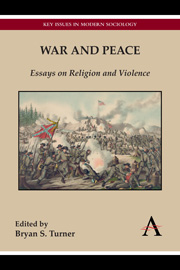Book contents
- Frontmatter
- Contents
- Acknowledgments
- Contributors
- Introduction by Bryan S. Turner
- War
- Peace
- Chapter 5 Quakers, the Origins of the Peace Testimony and Resistance to War Taxes
- Chapter 6 A Sacred Ground for Peace: Violence, Tourism and Sanctification in Hiroshima 1960—1970
- Chapter 7 The Sectarian as a Category of Secular Power: Sectarian Tensions and Judicial Authority in Lebanon
- Chapter 8 The Commodification of Love: Gandhi, King and 1960s Counterculture
- Chapter 9 The Religion of Brotherly Love: Leo Tolstoy and Max Weber
Chapter 6 - A Sacred Ground for Peace: Violence, Tourism and Sanctification in Hiroshima 1960—1970
from Peace
Published online by Cambridge University Press: 05 May 2013
- Frontmatter
- Contents
- Acknowledgments
- Contributors
- Introduction by Bryan S. Turner
- War
- Peace
- Chapter 5 Quakers, the Origins of the Peace Testimony and Resistance to War Taxes
- Chapter 6 A Sacred Ground for Peace: Violence, Tourism and Sanctification in Hiroshima 1960—1970
- Chapter 7 The Sectarian as a Category of Secular Power: Sectarian Tensions and Judicial Authority in Lebanon
- Chapter 8 The Commodification of Love: Gandhi, King and 1960s Counterculture
- Chapter 9 The Religion of Brotherly Love: Leo Tolstoy and Max Weber
Summary
Introduction
“Each time I get near the Peace Park,” wrote Kenzaburō Ōe in 1963, “I get the strong odor of politics” (1996, 45). And indeed the Hiroshima Peace Memorial Park in 1963 was a controversial and contested place. It is hard to believe it today, when the Peace Park, erected in 1955 to commemorate the site of the world's first use of a nuclear bomb, is largely a quiet and orderly memorial site frequented mostly by tourists and school groups, but in 1963 the park was the center of a worldwide radical antinuclear movement. This movement, though, was fast falling apart. With Gensuikyō (the Japanese Council Against Atomic and Hydrogen Weapons) split over the partial nuclear test ban treaty issue between pro-Chinese, pro-Soviet, liberal, radical and conservative factions, and with negotiations over a possible solution stalled, the antinuclear movement was on the verge of collapse. Many hibakusha and other activists were disgusted by the splits and factionalism. Then, on the eve of 6 August, the park saw some of the worst violence in its history when radical students from Zengakuren (the all-Japan student union) stormed the stage of the Ninth World Conference Against Nuclear Weapons.
- Type
- Chapter
- Information
- War and PeaceEssays on Religion and Violence, pp. 121 - 144Publisher: Anthem PressPrint publication year: 2013
- 1
- Cited by

